PCV valve 1.2TSI on valve cover
Discussion
Hello everyone:
I recently found some issues related to the PCV valve on a 1.2TSI CJZC, and I just wanted to share it with you.
This observations apply to 1.2TSI and 1.4TSI engines based on the EA211 platform, mounted on VW/Audi/Skoda/Seat/Cupra.
The summary is: Be careful if you change the PCV valve that lives on top of the valve cover and connects to the air filter, part number 04E103175. Some spare parts with this part number (even original VW ones!) are different to the one that your car came with, and these may completely mess up your engine!
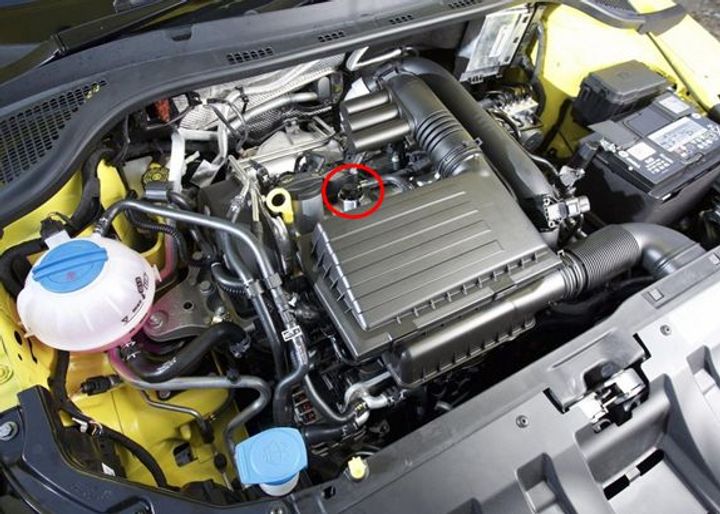
For those who want more detail:
Back in the day, a tiny tab on this aforementioned 04E103175 valve broke when I was removing the air filter to replace the spark plugs. It happens easily, more people report this on the internet. more people report this on the internet. This is completely harmless, the valve function is not affected.
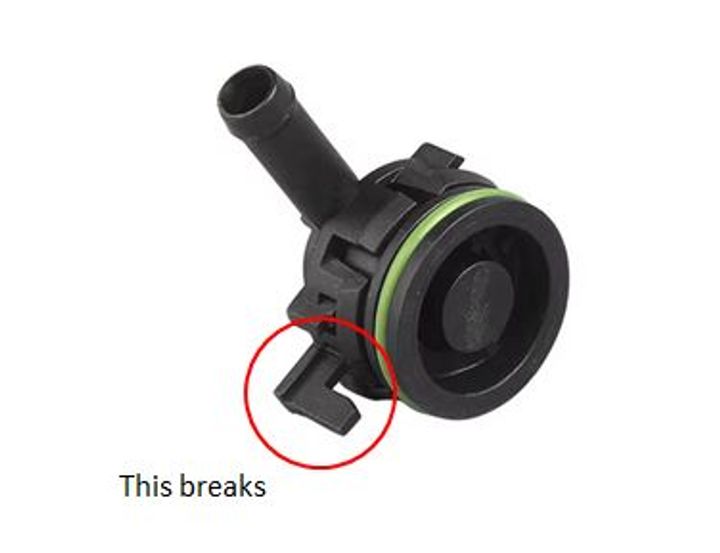
HOWEVER, since it looked bad and the engine had already 393.000km (244.000mi) I decided it was a good idea to replace it preventively, so I went to the dealership to buy a original spare part.
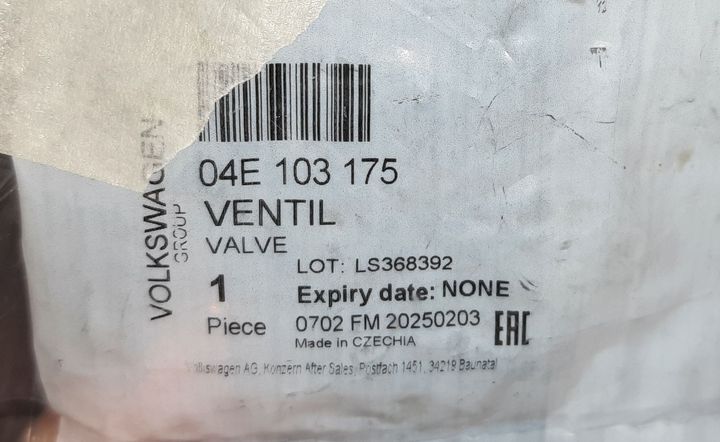
I also decided to change it at the same time I was replacing the water pump as I recently described in this post in this post.
Right after installing the new one, I noticed a different smell in the exhaust, enhanced by the fact that the car may or may not have an operational catalytic converter installed. I supposed the smell was just the fluids splashed over the engine during the water pump replacement that were slowly burning away, but not the exhaust itself. The smell was like a "burning smell".
I supposed the smell was just the fluids splashed over the engine during the water pump replacement that were slowly burning away, but not the exhaust itself. The smell was like a "burning smell".
After around 1000km, I started to notice I was spewing blueish smoke fom the exhaust in certain situations. In some ocasions the amount of smoke was obscene. After some analysis, I concluded the smoke was being generated only on overrun with no throttle input (such as going down a hIll, in gear, foot off the pedal), and then a big puff of smoke with the first throttle input. No smoke on continuous acceleration. The smell was oil being burnt. I was confused by the fact that this went worse over time, the engine was not smoking right after I put the new PCV.
At first I thought I had bad valve stem seals or piston rings, but the most plausible cause was the PCV. I decided to install the old one, and having both on my hands I noticed they WERE DIFFERENT!
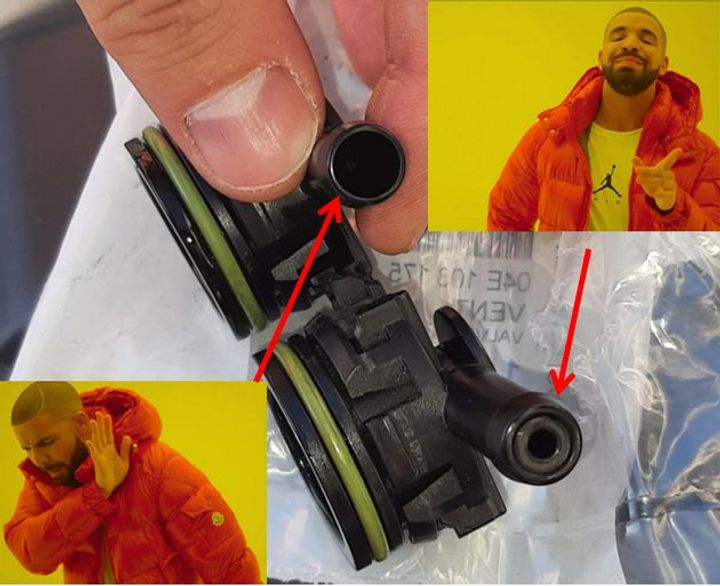
The old one had a restrictor, the new one has none.
Obviously, the smoke dissapeared as soon as I re-installed the old one.
Conclusions:
- If you car produces no smoke, don't change it.
- If you change it, make sure the new one has the restrictor.
- If you have my symptoms (smoke on overrun only), you may have a faulty PCV!
After further investigation, I confirmed this valve is just a check-valve or non-return valve, that allows only the flow from the filter to the crankcase. The crankcase ventilation is this engine is rather complex, and actually has 3 valves:
1) The one dicussed here, connecting the clean side of the filter to the valve cover (crankcase anyway)
2) A hose that goes from the oil separator to the turbo intake, with a check valve at the end, that allows only the flow towards the turbo (part number 04E103474BB).
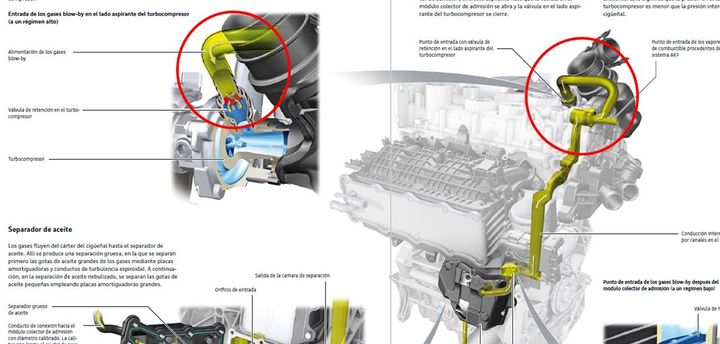
3) A third hose that connects the intake pipe between the throttle and the intercooler with the crankcase, also with a check valve at the end, that allows only the flow towards the intake pipe
 .
.
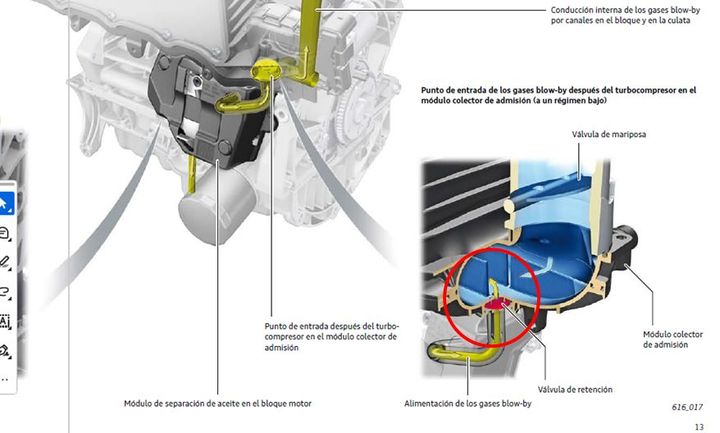
It's clear that on overrun, the vaccum in the intake creates also vaccum in the crankcase by opening valve 3. Valve 2 does not open (crankcase is under more vaccum than the turbo, upstream of the throttle valve), so the actual flow of clean air that scavenges the crankcase is controlled by the cross-section of valve 1. With the correctly sized restrictor the amount of air flowing across the crankcase is small, so very little amounts of oil vapours and mist go to the cylinders. Without restrictor, quite a lot of air enters the crankcase, carrying lots of oil mist to the cylinders, thus producing smoke.
That's my guess. Thanks for reading if you got this far.
Cheers!
I recently found some issues related to the PCV valve on a 1.2TSI CJZC, and I just wanted to share it with you.
This observations apply to 1.2TSI and 1.4TSI engines based on the EA211 platform, mounted on VW/Audi/Skoda/Seat/Cupra.
The summary is: Be careful if you change the PCV valve that lives on top of the valve cover and connects to the air filter, part number 04E103175. Some spare parts with this part number (even original VW ones!) are different to the one that your car came with, and these may completely mess up your engine!
For those who want more detail:
Back in the day, a tiny tab on this aforementioned 04E103175 valve broke when I was removing the air filter to replace the spark plugs. It happens easily, more people report this on the internet. more people report this on the internet. This is completely harmless, the valve function is not affected.
HOWEVER, since it looked bad and the engine had already 393.000km (244.000mi) I decided it was a good idea to replace it preventively, so I went to the dealership to buy a original spare part.
I also decided to change it at the same time I was replacing the water pump as I recently described in this post in this post.
Right after installing the new one, I noticed a different smell in the exhaust, enhanced by the fact that the car may or may not have an operational catalytic converter installed.
 I supposed the smell was just the fluids splashed over the engine during the water pump replacement that were slowly burning away, but not the exhaust itself. The smell was like a "burning smell".
I supposed the smell was just the fluids splashed over the engine during the water pump replacement that were slowly burning away, but not the exhaust itself. The smell was like a "burning smell".After around 1000km, I started to notice I was spewing blueish smoke fom the exhaust in certain situations. In some ocasions the amount of smoke was obscene. After some analysis, I concluded the smoke was being generated only on overrun with no throttle input (such as going down a hIll, in gear, foot off the pedal), and then a big puff of smoke with the first throttle input. No smoke on continuous acceleration. The smell was oil being burnt. I was confused by the fact that this went worse over time, the engine was not smoking right after I put the new PCV.
At first I thought I had bad valve stem seals or piston rings, but the most plausible cause was the PCV. I decided to install the old one, and having both on my hands I noticed they WERE DIFFERENT!
The old one had a restrictor, the new one has none.
Obviously, the smoke dissapeared as soon as I re-installed the old one.
Conclusions:
- If you car produces no smoke, don't change it.
- If you change it, make sure the new one has the restrictor.
- If you have my symptoms (smoke on overrun only), you may have a faulty PCV!
After further investigation, I confirmed this valve is just a check-valve or non-return valve, that allows only the flow from the filter to the crankcase. The crankcase ventilation is this engine is rather complex, and actually has 3 valves:
1) The one dicussed here, connecting the clean side of the filter to the valve cover (crankcase anyway)
2) A hose that goes from the oil separator to the turbo intake, with a check valve at the end, that allows only the flow towards the turbo (part number 04E103474BB).
3) A third hose that connects the intake pipe between the throttle and the intercooler with the crankcase, also with a check valve at the end, that allows only the flow towards the intake pipe
It's clear that on overrun, the vaccum in the intake creates also vaccum in the crankcase by opening valve 3. Valve 2 does not open (crankcase is under more vaccum than the turbo, upstream of the throttle valve), so the actual flow of clean air that scavenges the crankcase is controlled by the cross-section of valve 1. With the correctly sized restrictor the amount of air flowing across the crankcase is small, so very little amounts of oil vapours and mist go to the cylinders. Without restrictor, quite a lot of air enters the crankcase, carrying lots of oil mist to the cylinders, thus producing smoke.
That's my guess. Thanks for reading if you got this far.
Cheers!
Gassing Station | Engines & Drivetrain | Top of Page | What's New | My Stuff



